Experimental and Numerical Investigations of Bird Models for Bird Strike Analysis
Abstract
1. Introduction
2. Bird Strike Theory
2.1. Theoretical Foundation of Bird Impact Process
2.2. Equations of State (EOS)
2.2.1. Mie–Grüneisen EOS
2.2.2. Polynomial EOS
3. Materials and Methods
3.1. Experimental Setup
- -
- Air pressure gun;
- -
- Multi-channel recorder (LMS SCADAS Mobile SCR09);
- -
- Force sensors (M204C PCB)—4 pcs;
- -
- Strain gauges;
- -
- Portable computer equipped with LMS Test. XPress software—measurement control, data recording and archiving;
- -
- A desktop computer to control the gas gun equipped with Gun Control software;
- -
- High-speed camera (Phantom VEO 412L + TAMRON 28–75 mm);
- -
- Left high-speed camera (Phantom V1612 + NIKON 70–300 mm);
- -
- Right high-speed camera (Phantom V1612 + NIKON 105 mm);
- -
- Computer with PCC 3.1 camera software;
- -
- Samples for testing: steel rigid plate and plexiglass plate (0.5 × 0.5 × 0.1 m).
- -
- Measurement of projectile speed;
- -
- Measurement of impact force with four sensors;
- -
- Measurement of strains;
- -
- Pressure during impact;
- -
- Radial distribution of pressure.
3.2. Numerical Methods
3.2.1. Bird Models
3.2.2. Parameters of Simulations
4. Results
4.1. Experimental Results
4.2. Numerical Results
- The pressure plot of the center of impact can be obtained from the pressure variation of the most frontal elements of the bird model, which usually remains in its position from the initial instant of contact between the bird and the target until the final stages of the impact.
- The contact force plot is obtained and then divided by the initial contact area between the bird and the target.
- In a more accurate method of pressure reading, the contact force diagram is divided by the contact area between the bird and the target at any instance.
- The most accurate technique is to create a shell element as a sensor over the center of impact, the nodes of which are tied to the exterior face of the target plate. The contact force diagram between the bird and the shell sensor can be obtained and then divided by the area of the sensor.
5. Discussion
6. Conclusions
- -
- The deformation effect of the gelatin projectiles during impacts confirms their hydrodynamic behavior;
- -
- The exploited experimental setup allows for the recording of experimental parameters, such as impact force, projectile speed, effect of deformation, and changes in projectile diameter;
- -
- Values of Hugoniot and stagnation pressure depend on the technique of measurement during numerical simulations;
- -
- Values of Hugoniot and stagnation pressure for experimental tests depend on sensitivity pressure or load sensors (sample frequency);
- -
- The INTFOR technique seems to be the most accurate, providing results of pressures closest to the theoretical ones;
- -
- Many investigators do not provide their techniques of pressure recording, and thus it makes assessing their results’ accuracy difficult;
- -
- Applying 10% porosity, coupled with linear polynomial EOS, gives results close to the experimental test;
- -
- The resultant force values obtained during the numerical studies reflects well the experimental ones, regardless of the parameters of simulation used, such as pitch value and EOS.
- -
- SPH method for bird modelling with pitch value of 3 mm;
- -
- INTFOR technique for pressure measurement;
- -
- 10% porosity, coupled with linear polynomial EOS.
Author Contributions
Funding
Institutional Review Board Statement
Informed Consent Statement
Data Availability Statement
Acknowledgments
Conflicts of Interest
References
- Dhillon, B.S. Transportation Systems Reliability and Safety; Taylor and Francis Group: Boca Raton, FL, USA, 2011. [Google Scholar]
- Mclntyre, G.R. Patterns in Safety Thinking: A Literature Guide to Air Transportation Safety; Taylor and Francis Group: London, UK, 2017. [Google Scholar]
- Metz, I.; Mühlhausen, T.; Ellerbroek, J.; Kügler, D.; Gasteren, H.; Kraemer, J.; Hoekstra, J. Simulation Model to Calculate Bird-Aircraft Collisions and Near Misses in the Airport Vicinity. Aerospace 2018, 5, 112. [Google Scholar] [CrossRef]
- Metz, I.; Ellerbroek, J.; Mühlhausen, T.; Kügler, D.; Kern, S.; Hoekstra, J. The Efficacy of Operational Bird Strike Prevention. Aerospace 2021, 8, 17. [Google Scholar] [CrossRef]
- Dennis, L.; Lyle, D. Bird Strike Damage & Windshield Bird Strike Final Report; EASA.2008.C49; Report European Aviation Safety Agency: Cologne, Germany, 2009. [Google Scholar]
- Dolbeer, R.A.; Begier, M.J.; Miller, P.R.; Weller, J.R.; Anderson, A.L. Wildlife Strikes to Civil Aircraft in the United States, 1990–2020; Federal Aviation Administration: Washington, DC, USA, 2021. [Google Scholar]
- Ćwiklak, J. The Influence of a Bird Model Shape on Bird Impact Parameters. Facta Univ. Ser. Mech. Eng. 2020, 18, 639–651. [Google Scholar] [CrossRef]
- El-Sayed, A.F. Bird Strike in Aviation: Statistics, Analysis and Management; John Wiley & Sons: Hoboken, NJ, USA, 2019. [Google Scholar]
- EASA. CS-25, Certification Specifications for Large Aeroplanes, Amdt 11, EASA. 2011. Available online: https://www.easa.europa.eu/document-library/certification-specifications/cs-25-amendment-11 (accessed on 10 January 2022).
- EASA. CS-29, Certification Specifications, Acceptable Means of Compliance and Guidance Material for Large Rotorcraft, Amdt 9, EASA. 2021. Available online: https://www.easa.europa.eu/downloads/134339/en (accessed on 10 January 2022).
- Kalam, A.; Kumar, R.; Ranga; Janardhana, G. SPH High Velocity Impact Analysis-Influence of Bird Shape on Rigid Flat Plate. Mater. Today Proc. 2017, 4, 2564–2572. [Google Scholar] [CrossRef]
- Delsart, D.; Boyer, F.; Vagnot, A. Assessment of a substitute bird model for the prediction of bird-strike of helicopters structures. In Proceedings of the 7th International Conference on Mechanics and Materials in Design, Albufeira, Portugal, 11–15 June 2017; pp. 997–1010. [Google Scholar]
- Liu, J.; Li, Y.; Gao, X. Bird strike on a flat plate: Experiments and numerical simulations. Int. J. Impact Eng. 2014, 70, 21–37. [Google Scholar] [CrossRef]
- Guida, M.; Marulo, F.; Meo, M.; Russo, S. Certification by birdstrike analysis on C27J full scale ribless composite leading edge. Int. J. Impact Eng. 2013, 54, 105–113. [Google Scholar] [CrossRef]
- Pernas-Sánchez, J.; Artero-Guerrero, J.; Varas, D.; López-Puente, J. Artificial bird strike on Hopkinson tube device: Experi-mental and numerical analysis. Int. J. Impact Eng. 2020, 138, 103477. [Google Scholar] [CrossRef]
- Allaeys, F.; Luyckx, G.; Van Paepegem, W.; Degrieck, J. Numerical and experimental investigation of the shock and steady state pressures in the bird material during bird strike. Int. J. Impact Eng. 2017, 107, 12–22. [Google Scholar] [CrossRef]
- Wilbeck, J.S. Impact Behavior of Low Strength Projectiles; Technical Report AFML-TR-77-134; Air Force Materials Laboratory: Dayton, OH, USA, 1977. [Google Scholar]
- Barber, J.P. Bird Impact Forces and Pressures on Rigid and Compliant Targets; Technical Report AFFDL-TR-77-60; Air Force Flight Dynamics Laboratory: Wright-Patterson AFB, OH, USA, 1978. [Google Scholar]
- Hedayati, R.; Sadighi, M. Bird Strike: An Experimental, Theoretical and Numerical Investigation; Woodhead Publishing: Cambridge, UK, 2015. [Google Scholar]
- Lavoie, M.A.; Gakwaya, A.; Nejad Ensan, M.; Zimcik, D.G.; Nandlall, D. Bird’s substitute tests results and evaluation of available numerical methods. Int. J. Impact Eng. 2009, 36, 1276–1287. [Google Scholar] [CrossRef]
- Hedayati, R.; Ziaei-Rad, S. A new bird model and Effect of bird geometry and orientation on bird-target impact analysis using SPH method. Int. J. Crashworthiness 2012, 17, 445–459. [Google Scholar] [CrossRef]
- Hedayati, R.; Sadighi, M.; Mohammadi-Aghdam, M. On the difference of pressure readings from the numerical, experimental and theoretical results in different bird strike studies. Aerosp. Sci. Technol. 2014, 32, 260–266. [Google Scholar] [CrossRef]
- Zhang, D.; Fei, Q. Effect of bird geometry and impact orientation in bird striking on a rotary jet-engine fan analysis using SPH method. Aerosp. Sci. Technol. 2016, 54, 320–329. [Google Scholar] [CrossRef]
- Chuan, K.C. Finite Element Analysis of Bird Strikes on Composite and Glass Panels. Ph.D. Thesis, Department of Mechanical Engineering, National University of Singapore, Singapore, 2006. [Google Scholar]
- Heimbs, S. Computational methods for bird strike simulations: A review. Comput. Struct. 2011, 89, 2093–2112. [Google Scholar] [CrossRef]
- Dar, U.A.; Zhang, W.; Xu, Y. FE Analysis of Dynamic Response of Aircraft Windshield against Bird Impact. Int. J. Aerosp. Eng. 2013, 2013, 171768. [Google Scholar] [CrossRef]
- Yang, J.; Cai, X.; Wu, C. Experimental and FEM study of windshield subjected to high speed bird impact. Acta Mech. Sin. 2003, 19, 543–550. [Google Scholar]
- Wang, F.; Yue, Z. Numerical simulation of damage and failure in aircraft windshield structure against bird strike. Mater. Des. 2010, 31, 687–695. [Google Scholar] [CrossRef]
- Lavoie, M.A.; Gakwaya, A.; Nejad Ensan, M.; Zimcik, D.G. Validation of available approaches for numerical bird strike mod-eling tools. Int. Rev. Mech. Eng. 2007, 1, 380–389. [Google Scholar]
- Hedayati, R.; Ziaei-Rad, S. A new bird model and the effect of bird geometry in impacts from various orientations. Aerosp. Sci. Technol. 2013, 28, 9–20. [Google Scholar] [CrossRef]
- Soni, C.; Katukam, R. Bird Strike Analysis of an Airframe, Comparison of Methods and Validation. In Proceedings of the Simulia India Regional User Meeting ’13, Hyderabad, India, 2013. 2013, pp. 1–14. Available online: https://www.academia.edu/38652365/Bird_Strike_Analysis_of_an_Airframe_Comparison_of_Methods_and_Validation (accessed on 10 January 2022).
- Husainie, S.N. Bird Strike and Novel Design of Fan Blades. In Proceedings of the Science in the Age of Experience, Chicago, IL, USA, 15–18 May 2017. [Google Scholar]
- Ivančević, D.; Smojver, I. Hybrid approach in bird strike damage prediction on aeronautical composite structures. Compos. Struct. 2011, 94, 15–23. [Google Scholar] [CrossRef][Green Version]
- Lacome, J.L. Smoothed particle hydrodynamics method in LS-DYNA. In Proceedings of the 3rd German LS-DYNA Forum, Bamberg, Germany, 2004; pp. 7–33. [Google Scholar]
- Fragassa, C.; Topalovic, M.; Pavlovic, A.; Vulovic, S. Dealing with the Effect of Air in Fluid Structure Interaction by Coupled SPH-FEM Methods. Materials 2019, 12, 1162. [Google Scholar] [CrossRef]
- Zhu, S.; Wu, C.; Yin, H. Virtual Experiments of Particle Mixing Process with the SPH-DEM Model. Materials 2021, 14, 2199. [Google Scholar] [CrossRef] [PubMed]
- Lyu, H.-G.; Sun, P.-N.; Huang, X.-T.; Zhong, S.-Y.; Peng, Y.-X.; Jiang, T.; Ji, C.-N. A Review of SPH Techniques for Hydrodynamic Simulations of Ocean Energy Devices. Energies 2022, 15, 502. [Google Scholar] [CrossRef]
- Ropero-Giralda, P.; Crespo, A.J.C.; Coe, R.G.; Tagliafierro, B.; Domínguez, J.M.; Bacelli, G.; Gómez-Gesteira, M. Modelling a Heaving Point-Absorber with a Closed-Loop Control System Using the DualSPHysics Code. Energies 2021, 14, 760. [Google Scholar] [CrossRef]
- Mccarthy, M.A.; Xiao, J.R.; Mccarthy, C.T.; Kamoulakos, A.; Ramos, J.; Gallard, J.P.; Melito, V. Modelling Bird Impacts on an Aircraft Wing—Part 2: Modelling the Impact with an SPH Bird Model. Int. J. Crashworthiness 2005, 10, 51–59. [Google Scholar] [CrossRef]
- Plassarda, F.; Hereil, P.; Pierric, J.; Mespoulet, J. Experimental and numerical study of a bird strike against a windshield. Eu-Ropean Phys. J. Web Conf. 2015, 94, 01051. [Google Scholar] [CrossRef]
- Ćwiklak, J. Numerical simulations of a bird strike against a helicopter windshield. J. KONES Powertrain Transp. 2018, 25, 81–88. [Google Scholar]
- Arachchige, B.; Ghasemnejad, H.; Yasaee, M. Effect of bird-strike on sandwich composite aircraft wing leading edge. Adv. Eng. Softw. 2020, 148, 102839. [Google Scholar] [CrossRef]
- Ansari, H. Bird Strike Damage Analysis on a Model of a Business Jet Composite Wing Leading Edge. Unpublished MSC by. Master’s Thesis, Coventry: Coventry University, Coventry, UK, 2016. [Google Scholar]
- Di Caprio, F.; Sellitto, A.; Saputo, S.; Guida, M.; Riccio, A. A Sensitivity Analysis of the Damage Behavior of a Leading-Edge Subject to Bird Strike. Appl. Sci. 2020, 10, 8187. [Google Scholar] [CrossRef]
- Zhou, Y.; Sun, Y.; Huang, T. SPH-FEM Design of Laminated Plies under Bird-Strike Impact. Aerospace 2019, 6, 112. [Google Scholar] [CrossRef]
- Zhou, Y.; Sun, Y.; Huang, T. Bird-Strike Resistance of Composite Laminates with Different Materials. Materials 2019, 13, 129. [Google Scholar] [CrossRef]
- Jin, Y. A review of research on bird impacting on jet engines. In Proceedings of the IOP Conference Series, Materials Science and Engineering, Kuala Lumpur, Malaysia, 13 August 2018; p. 012014. [Google Scholar]
- Wu, B.; Lin, J.; Hedayati, R.; Zhang, G.; Zhang, J.; Zhang, L. Dynamic Responses of the Aero-Engine Rotor System to Bird Strike on Fan Blades at Different Rotational Speeds. Appl. Sci. 2021, 11, 8883. [Google Scholar] [CrossRef]
- Zhang, Z.; Li, L.; Zhang, D. Effect of arbitrary yaw/pitch angle in bird strike numerical simulation using SPH method. Aerosp. Sci. Technol. 2018, 81, 284–293. [Google Scholar] [CrossRef]
- Heimbs, S. Bird Strike Simulations on Composite Aircraft Structures. In Proceedings of the Simulia Customer Conference, Barcelona, Spain, 17–19 May 2011; pp. 1–13. [Google Scholar]
- Vijayakumar, R.; Gulbarga, K.; Ravindranath, R. Bird strike simulation on composite structures. In Proceedings of the 41st European Rotorcraft Forum, Munich, Germany, 19–20 May 2015. [Google Scholar]
- Hedayati, R.; Ziaei-Rad, S.; Eyvazian, A.; Hamouda, A.M. Bird strike analysis on a typical helicopter windshield with different lay-ups. J. Mech. Sci. Technol. 2014, 28, 1381–1392. [Google Scholar] [CrossRef]
- Orlando, S.; Marulo, F.; Guida, M.; Timbrato, F. Bird strike assessment for a composite wing flap. Int. J. Crashworthiness 2017, 23, 219–235. [Google Scholar] [CrossRef]
- Guida, M.; Marulo, F.; Meo, M.; Grimaldi, A.; Olivares, G. SPH—Lagrangian study of bird impact on leading edge wing. Compos. Struct. 2011, 93, 1060–1071. [Google Scholar] [CrossRef]
- Liu, J.; Yulonga, L.; Xiaoshengb, G.; Xiancheng, Y. A numerical model for bird strike on side wall structure of an aircraft nose. Chin. J. Aeronaut. 2014, 27, 542–549. [Google Scholar] [CrossRef]
- Airoldi, B.; Cacchione. Modeling of Impact Forces and Pressures in Lagrangian Bird Strike Analyses. Int. J. Impact Eng. 2006, 32, 1651–1677. [Google Scholar] [CrossRef]
- Ćwiklak, J. Numerical simulations of bird strikes with the use of various equations of state. J. KONBiN 2020, 50, 333–345. [Google Scholar] [CrossRef]
- Ugrčić, M. Application of the Hydrodynamic Theory and the Finite Element Method in the Analysis of Bird Strike in a Flat Barrier. Sci. Techn. Rev. 2012, 62, 28–37. [Google Scholar]
- Livermore Software Technology Corporation. LS-DYNA Keyword User’s Manual; Livermore Software Technology Corporation: Livermore, CA, USA, 2007. [Google Scholar]
- Zochowski, P.; Bajkowski, M.; Grygoruk, R.; Magier, M.; Burian, W.; Pyka, D.; Bocian, M.; Jamroziak, K. Comparison of Numerical Simulation Techniques of Ballistic Ceramics under Projectile Impact Conditions. Materials 2022, 15, 18. [Google Scholar] [CrossRef]

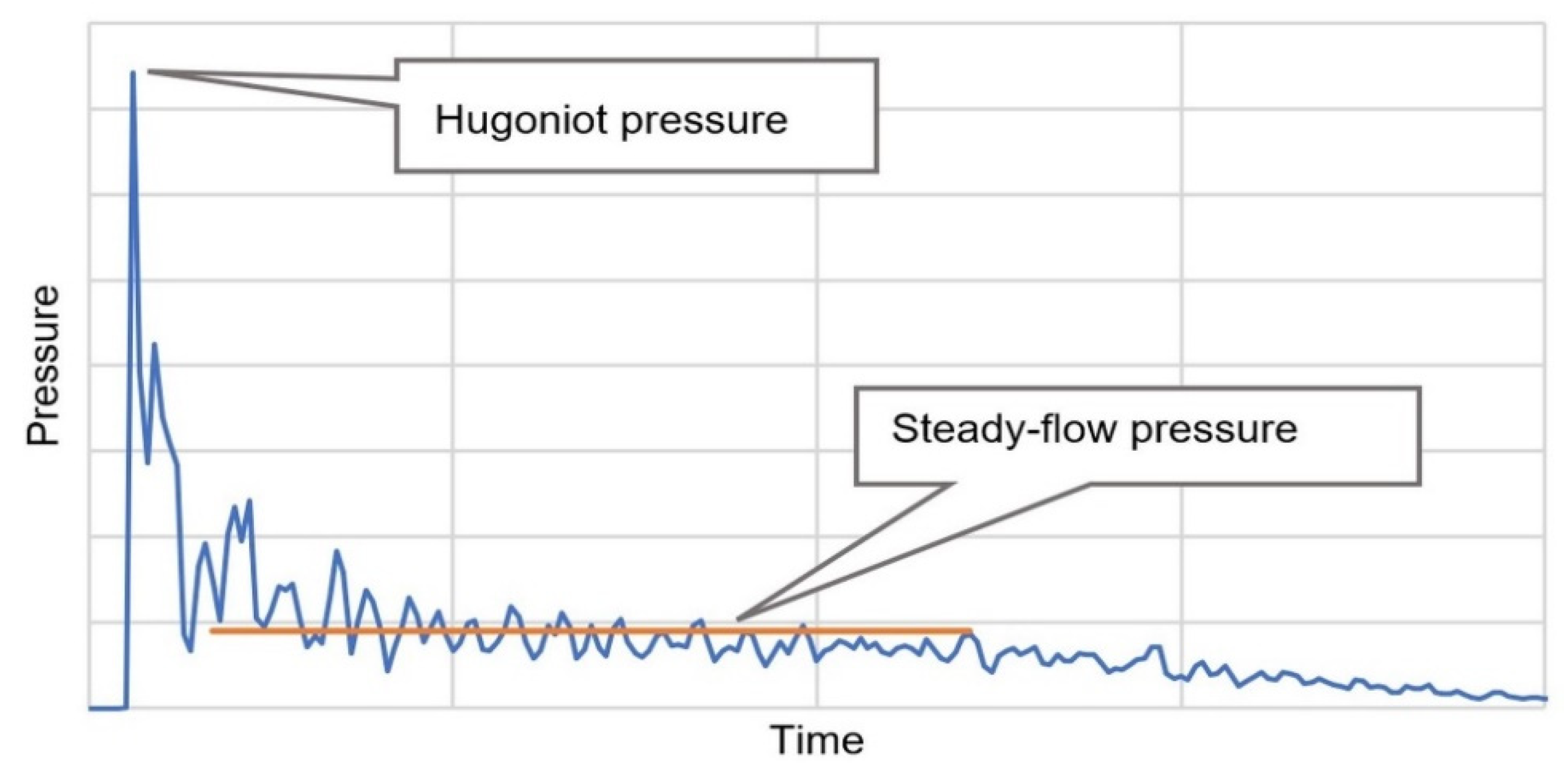
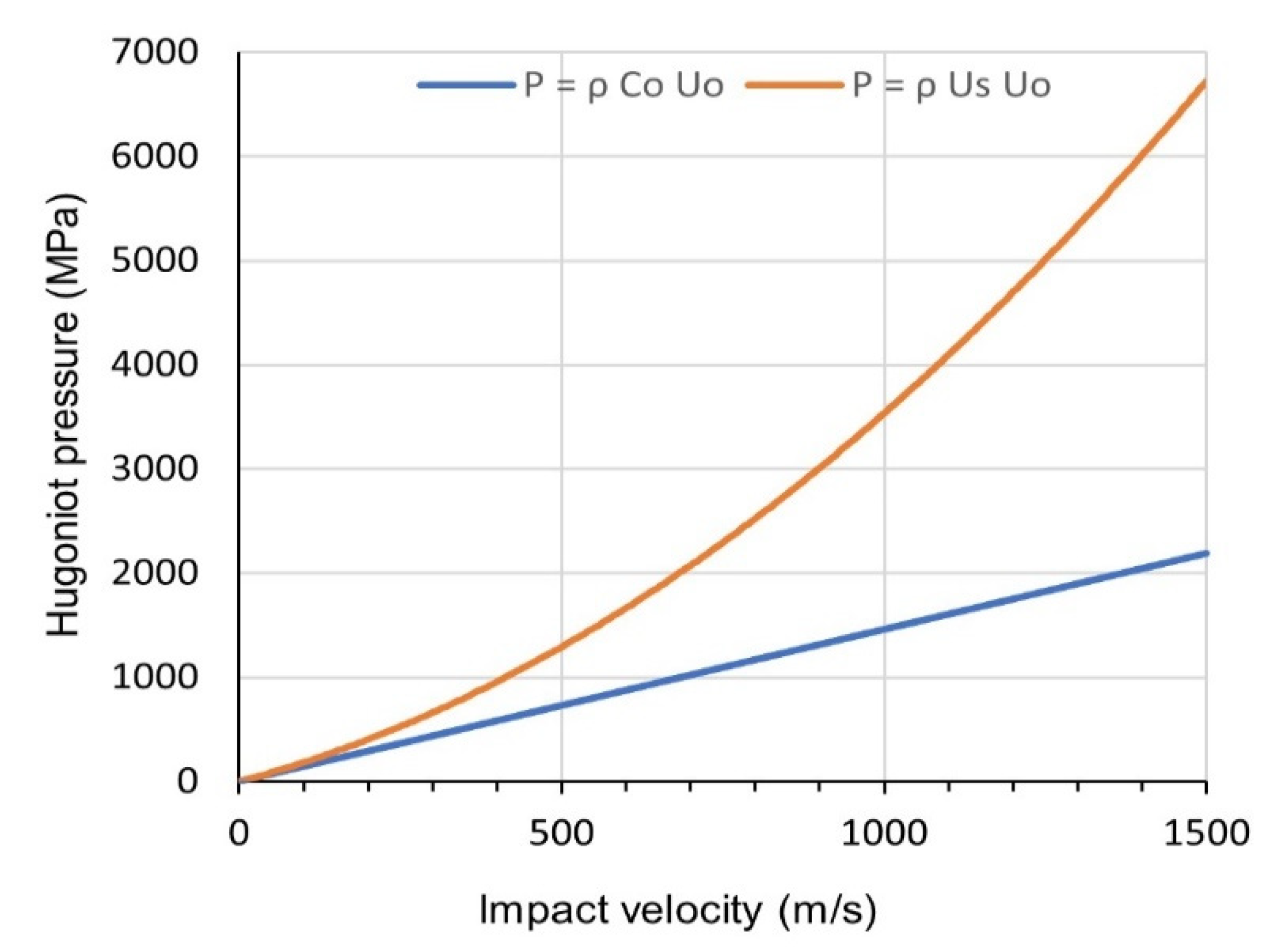
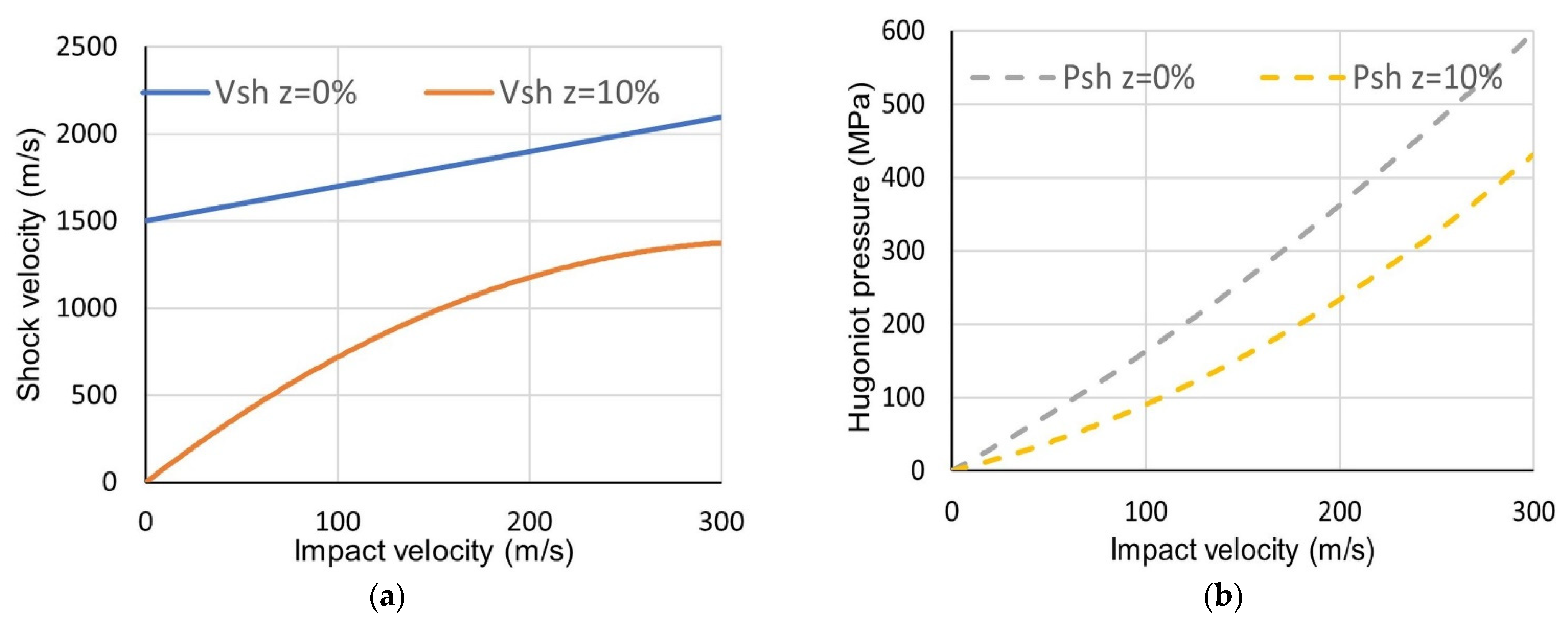

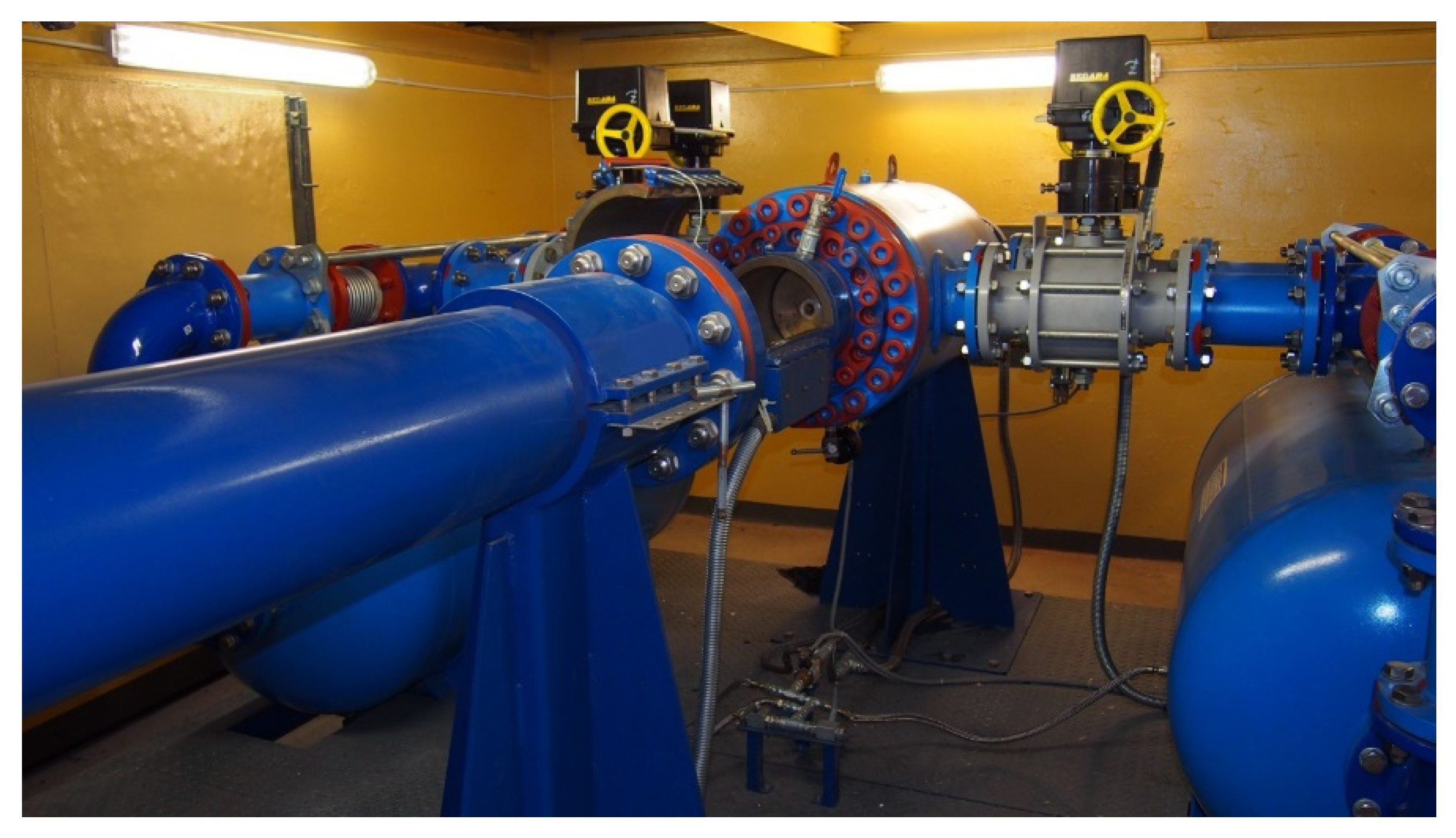

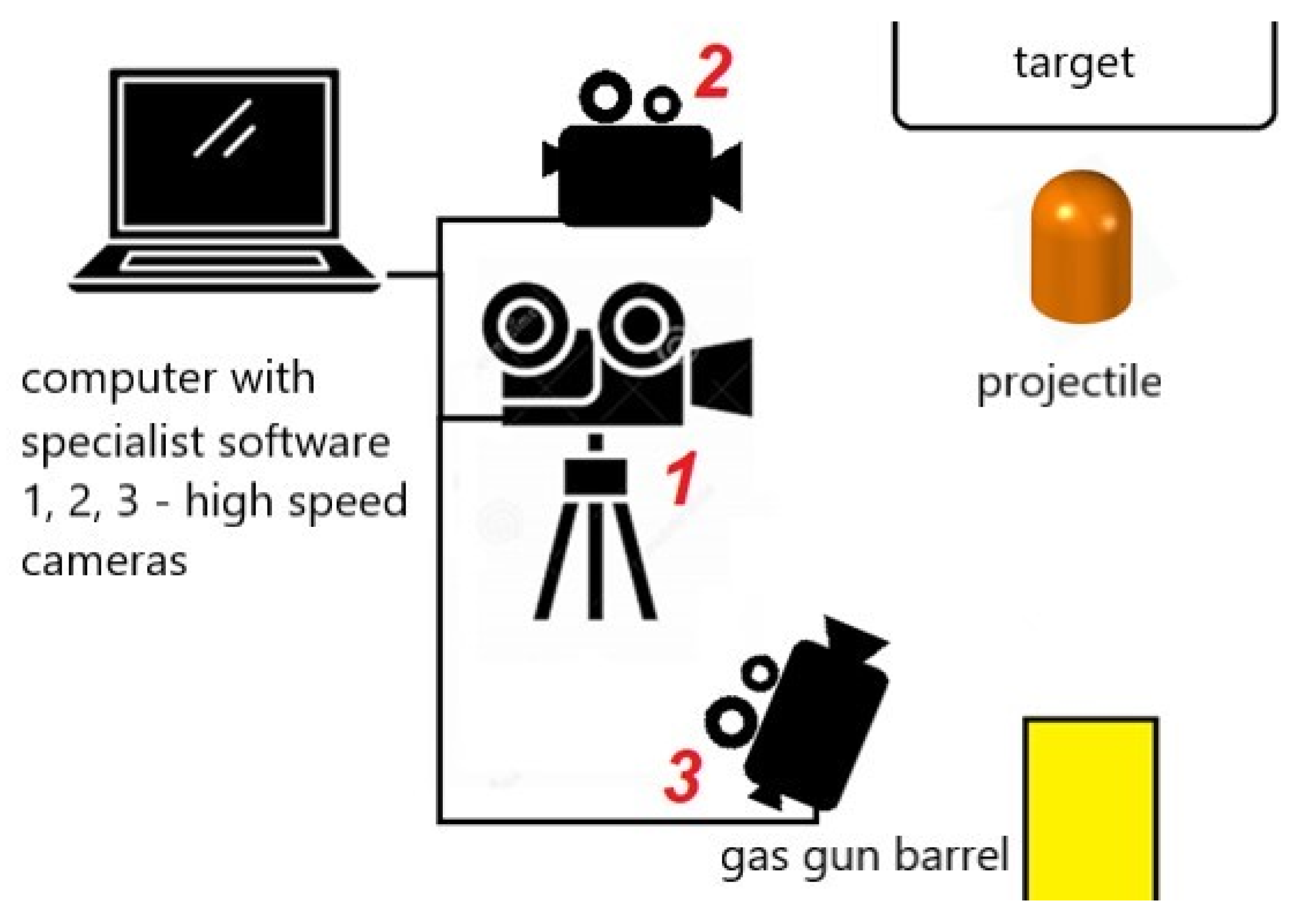

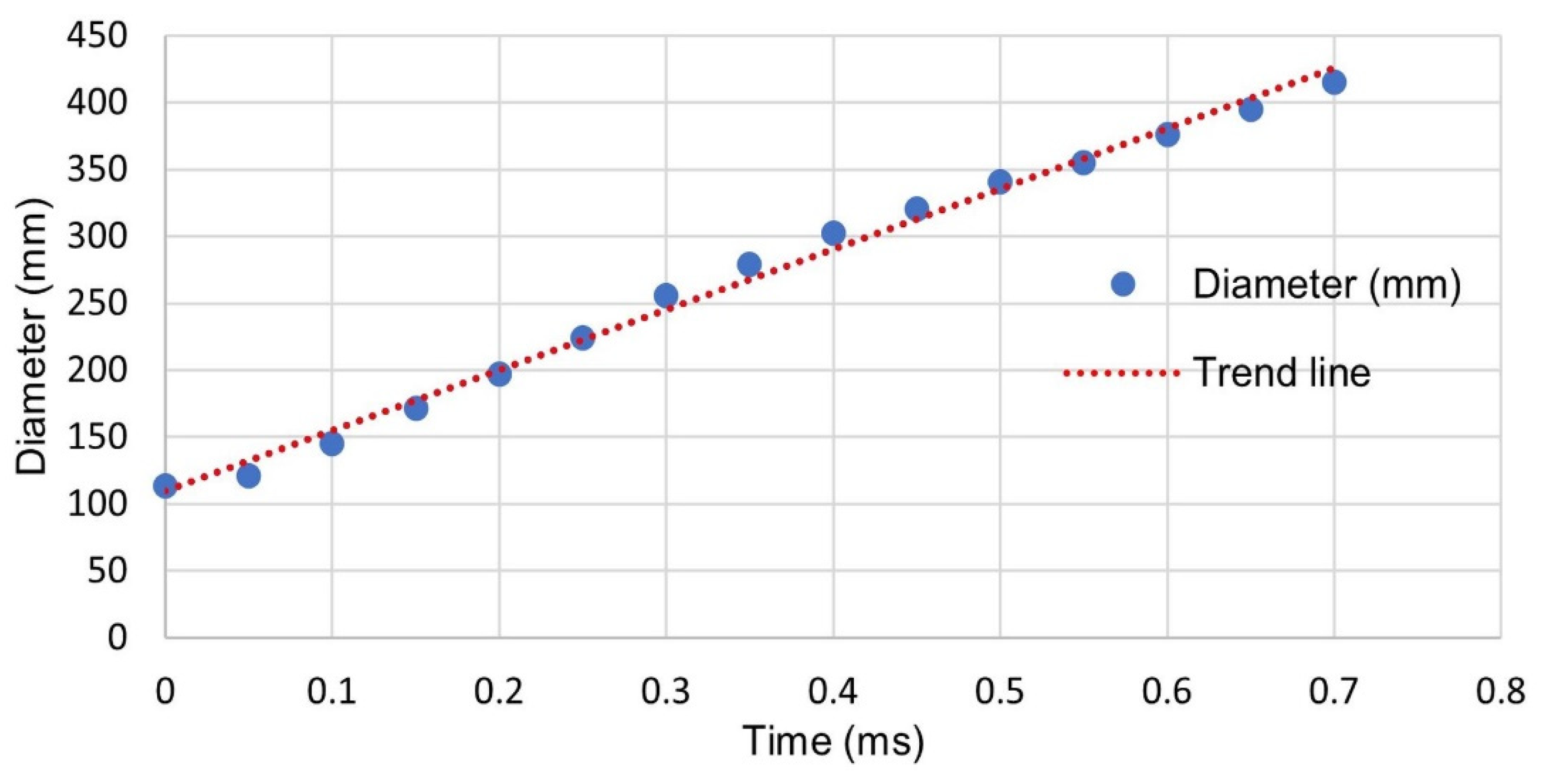
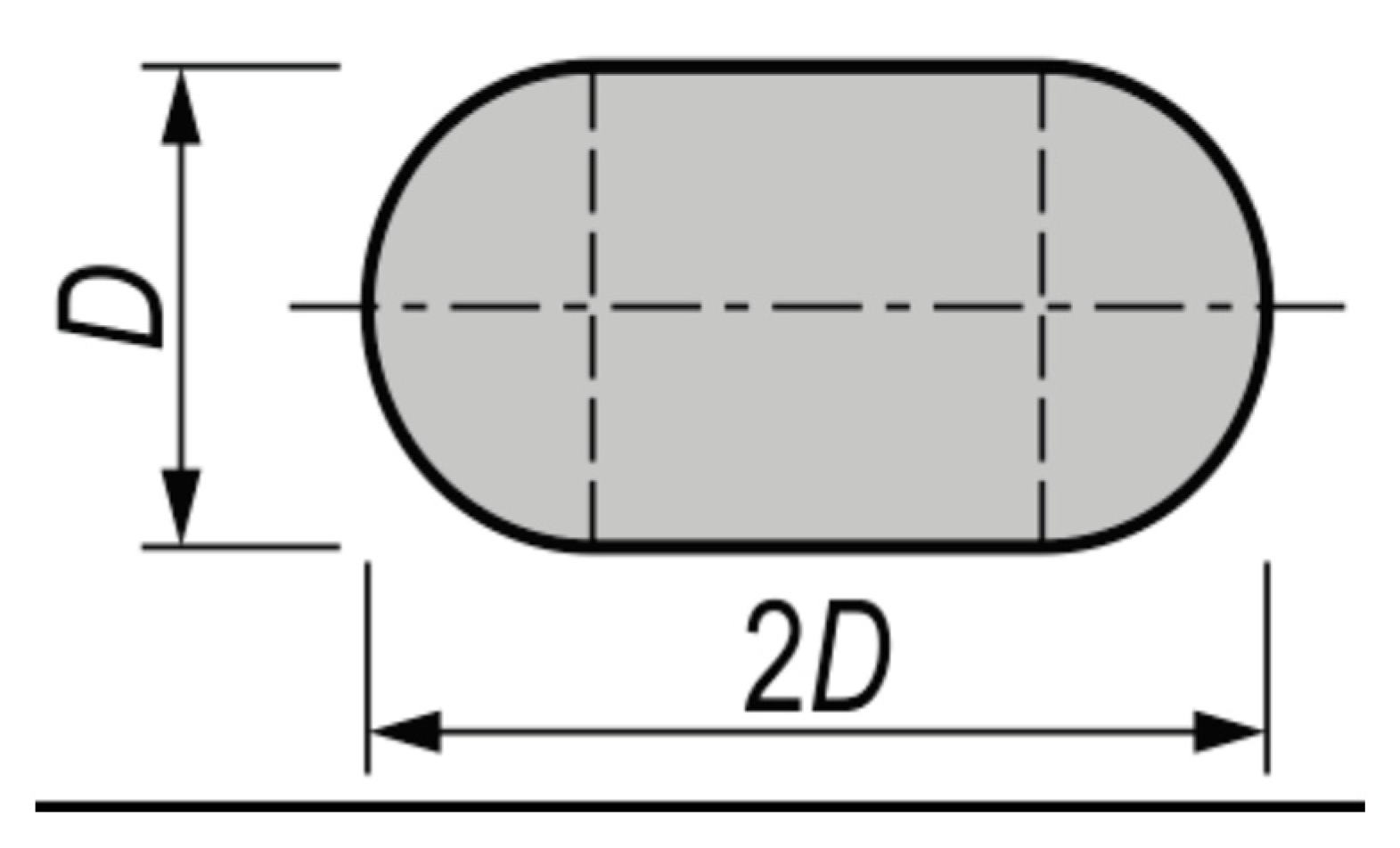

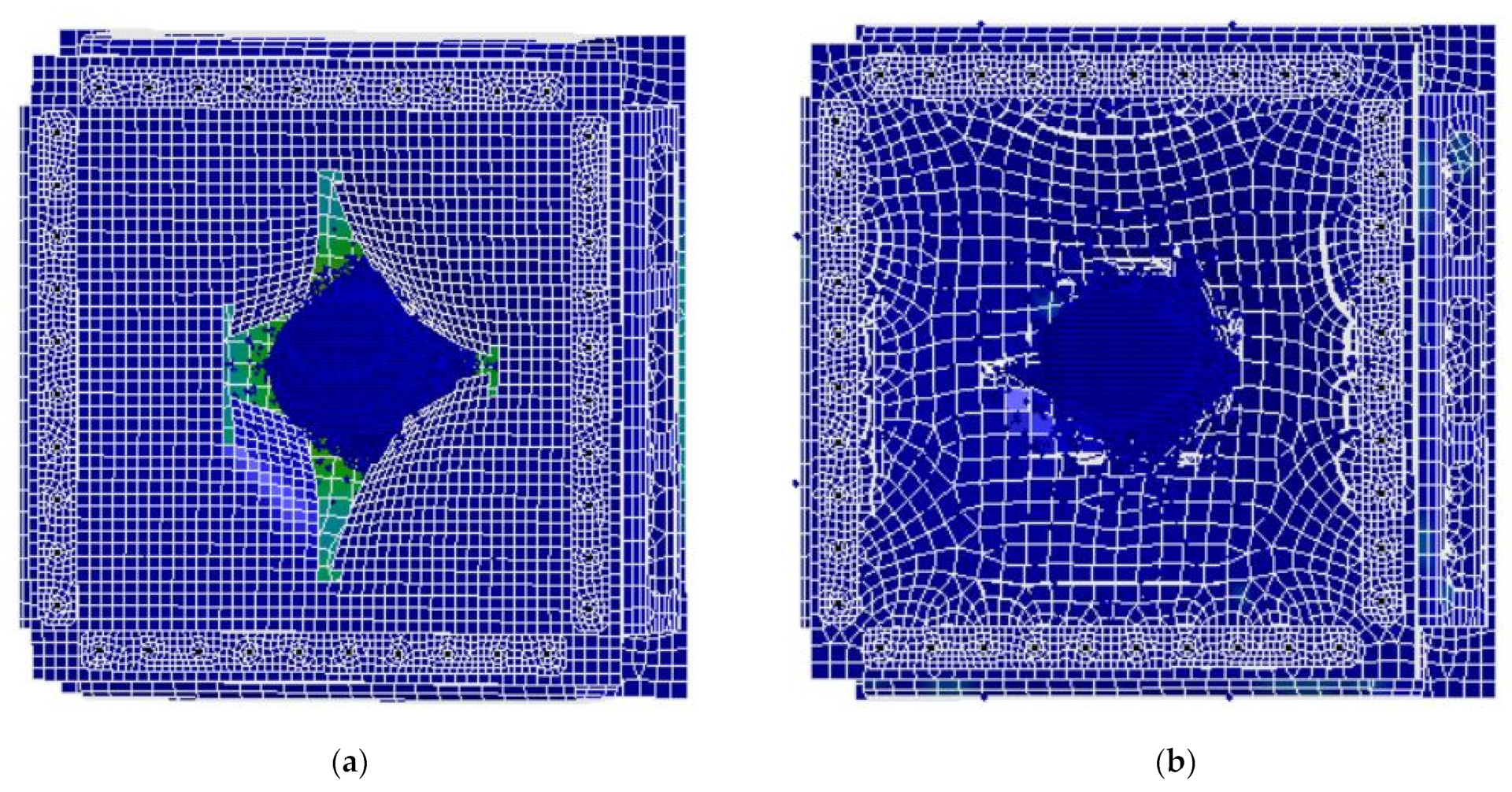
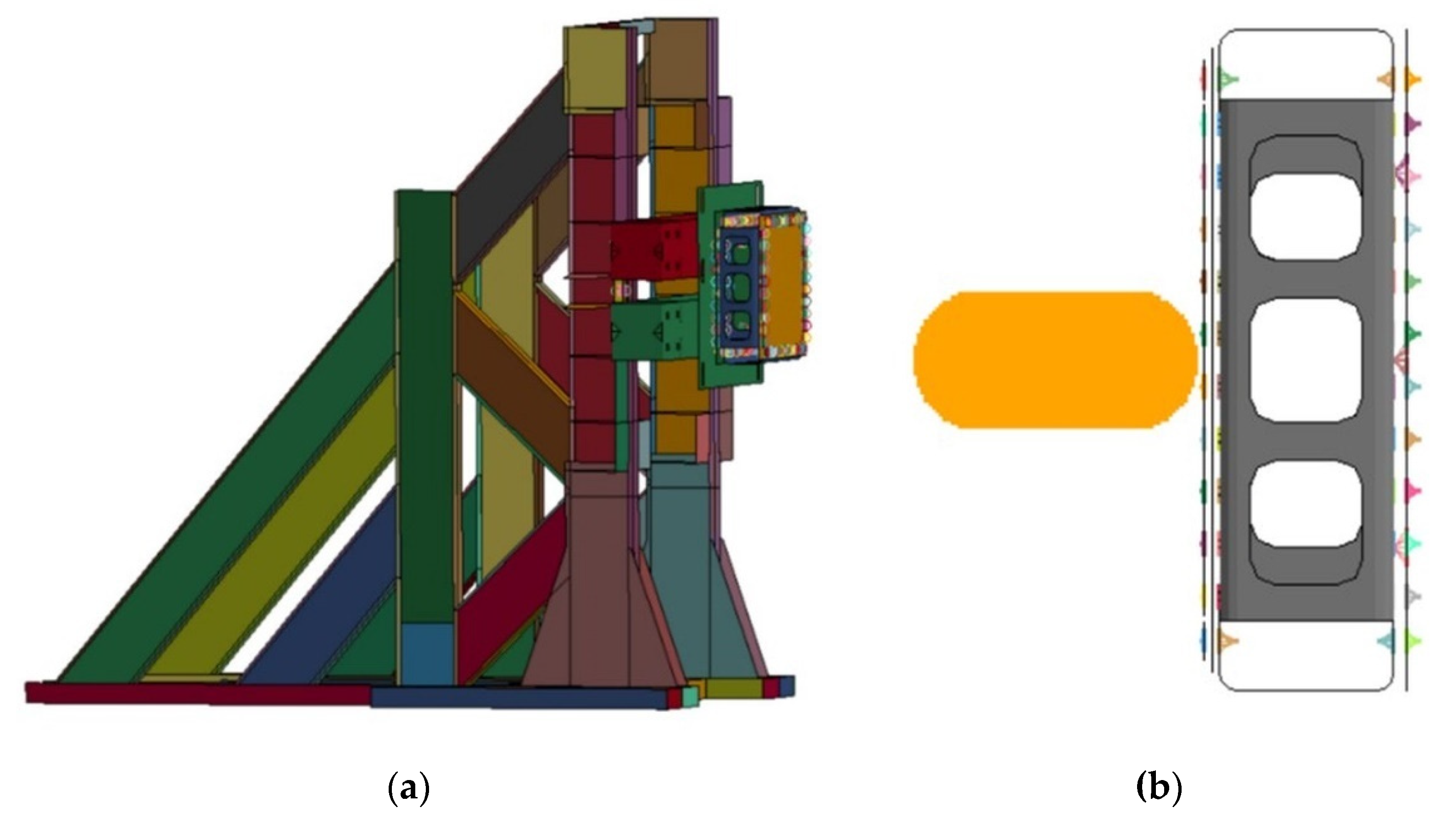
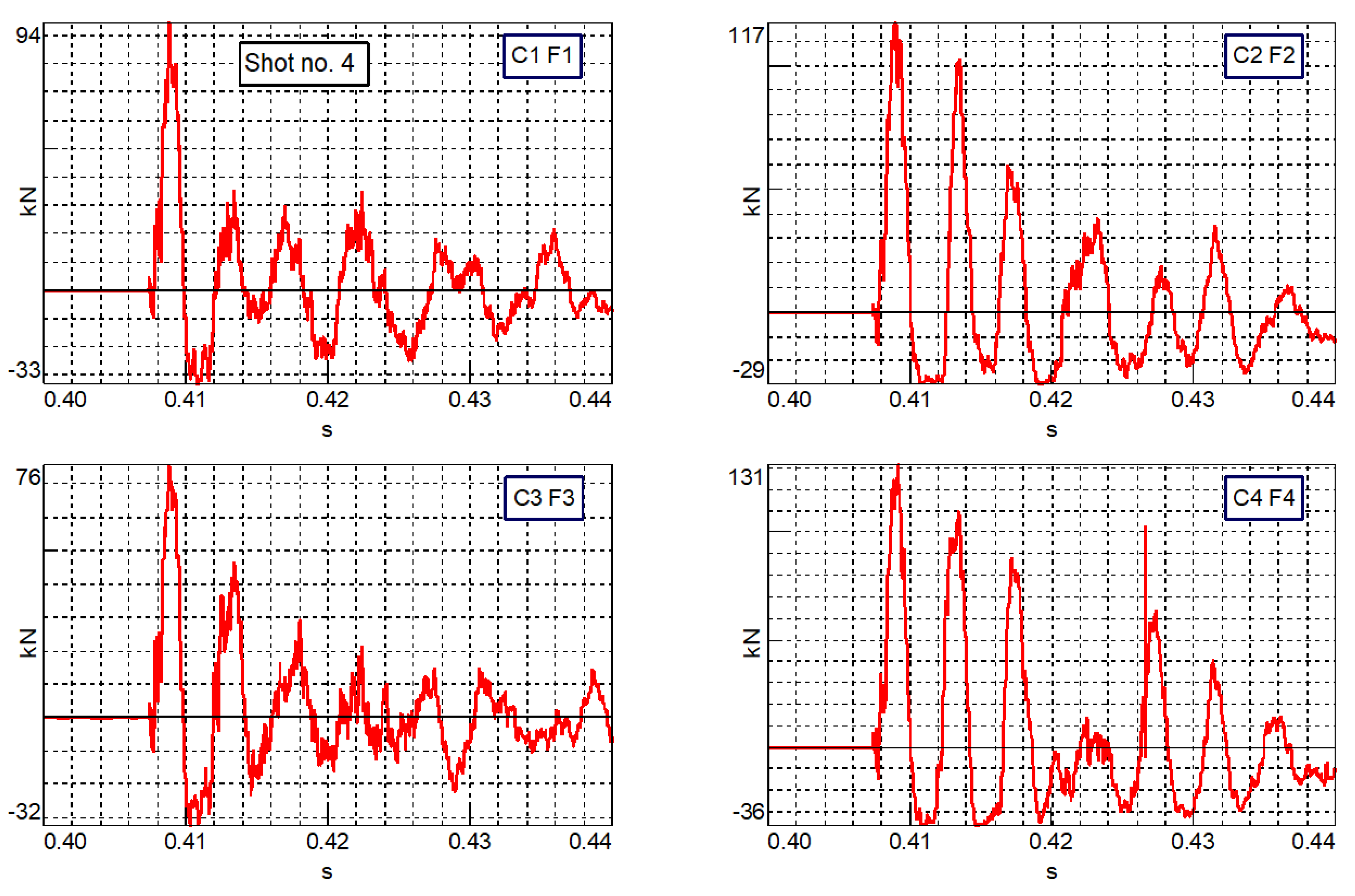
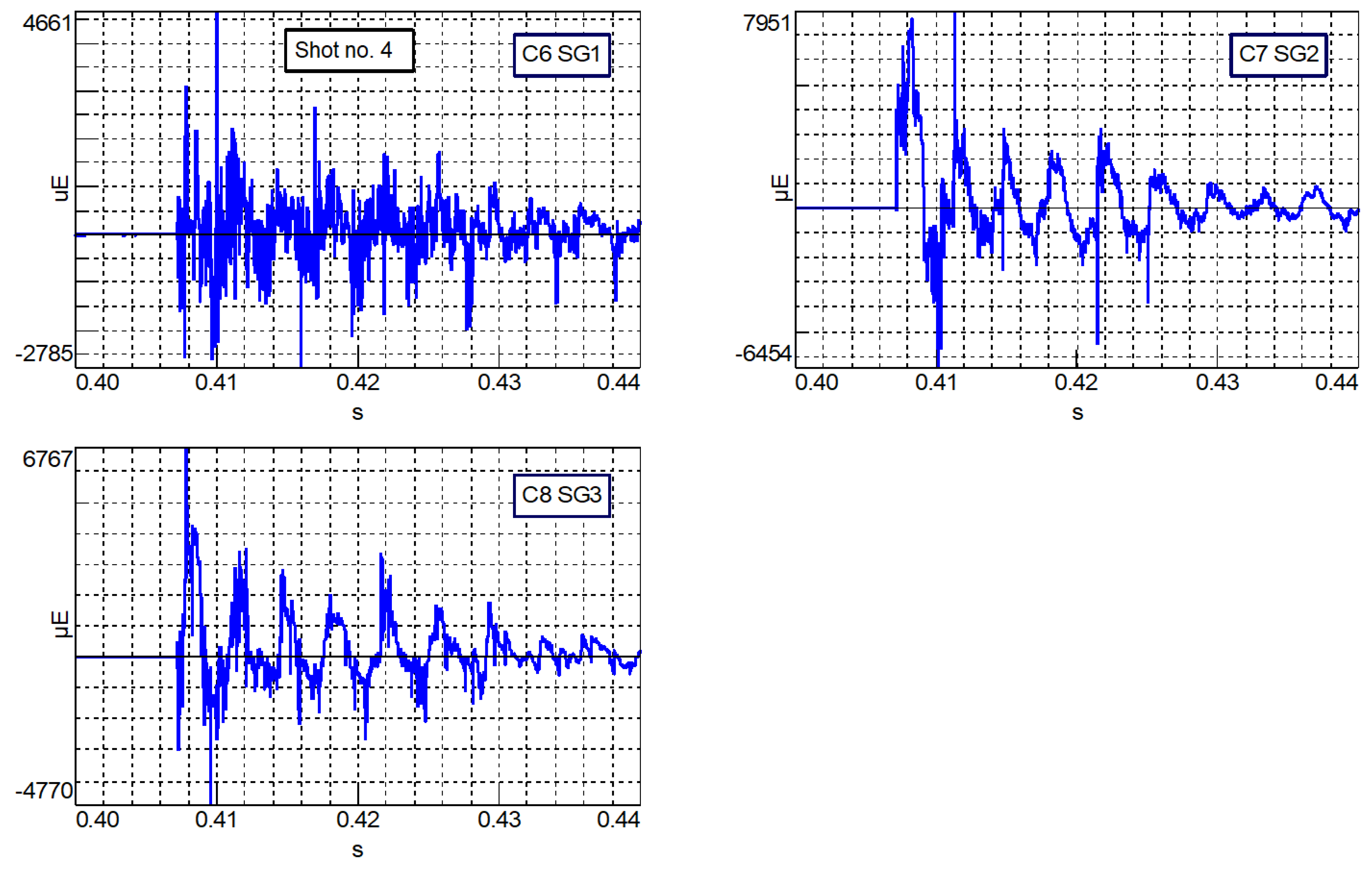


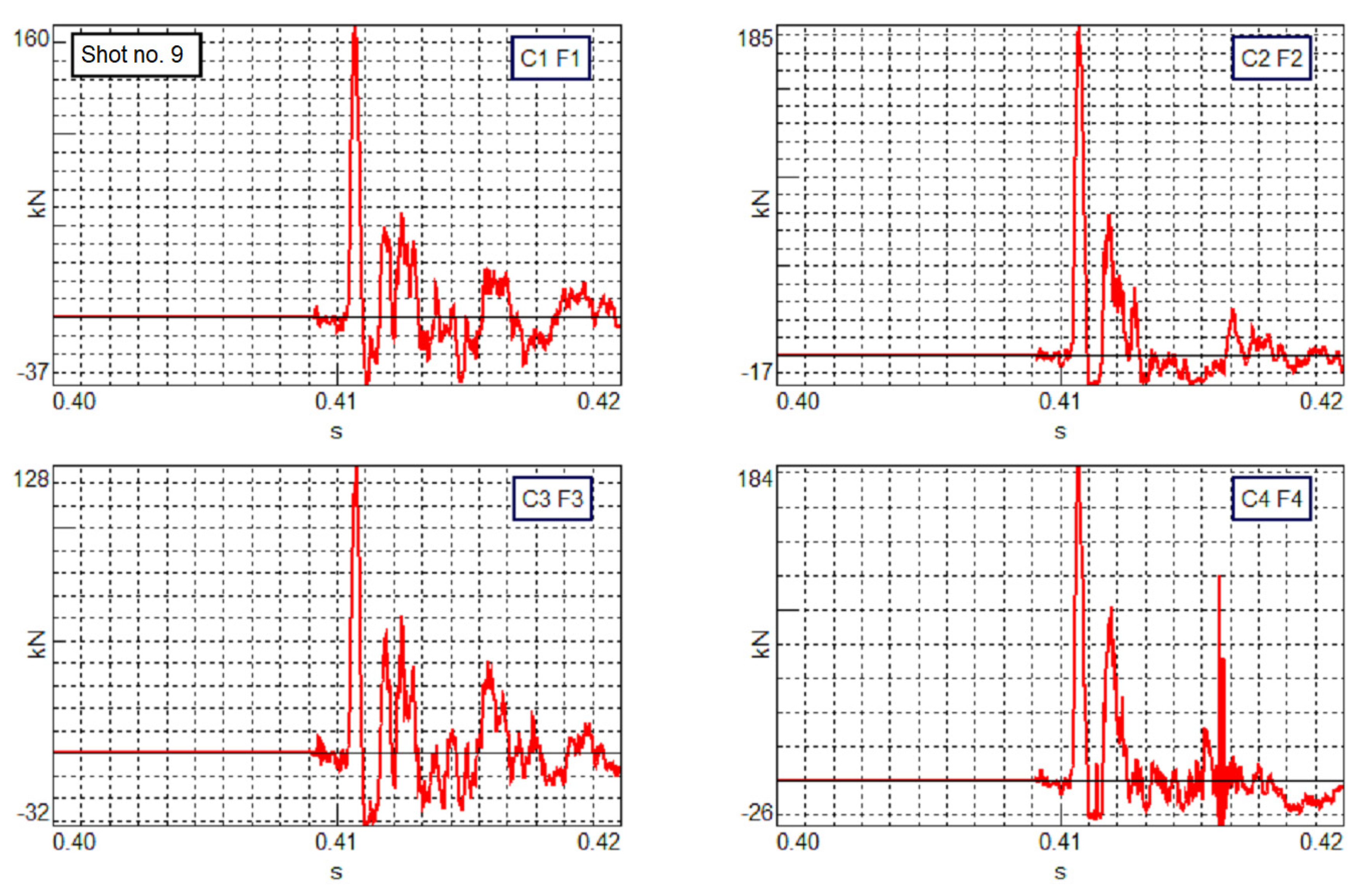
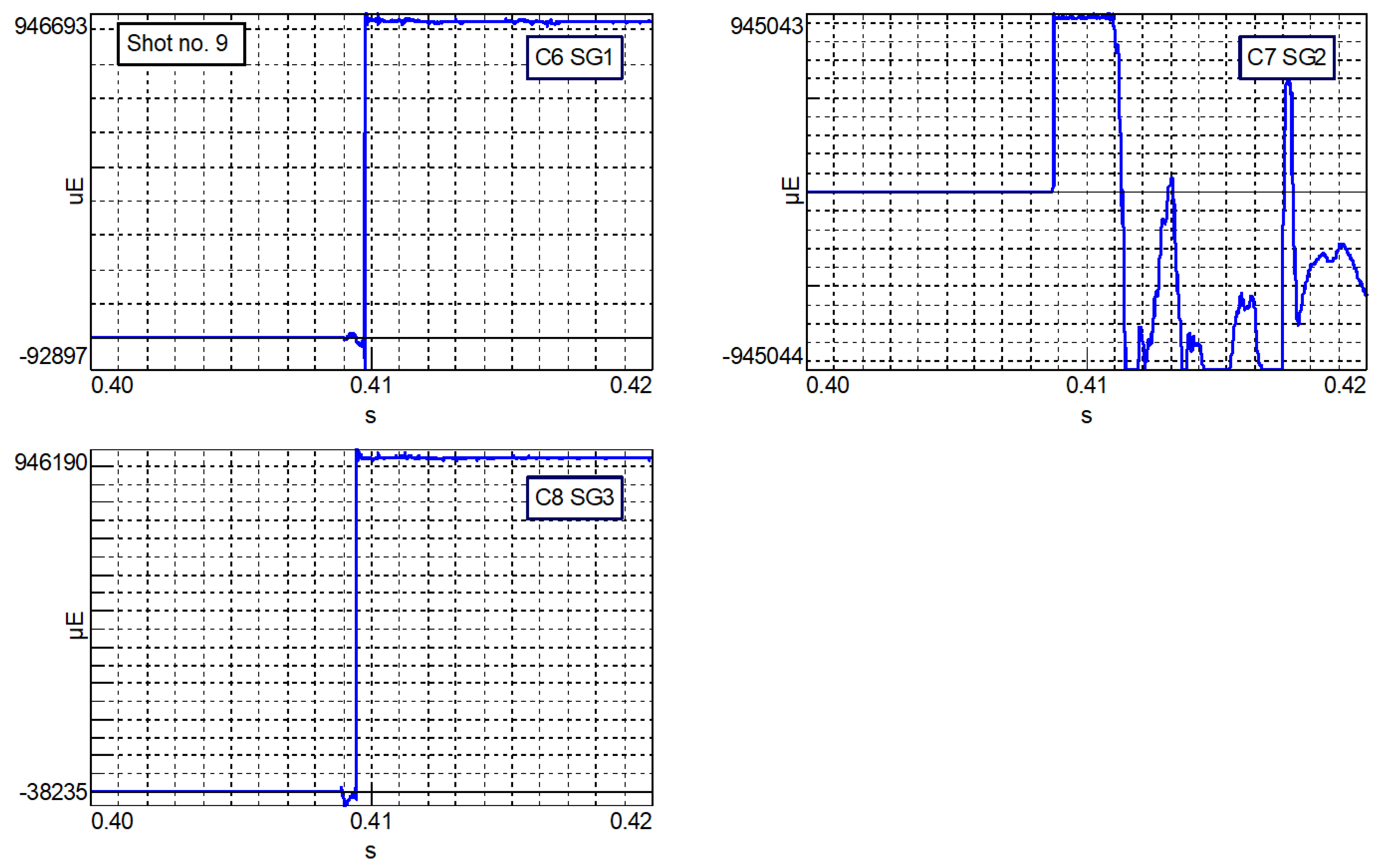
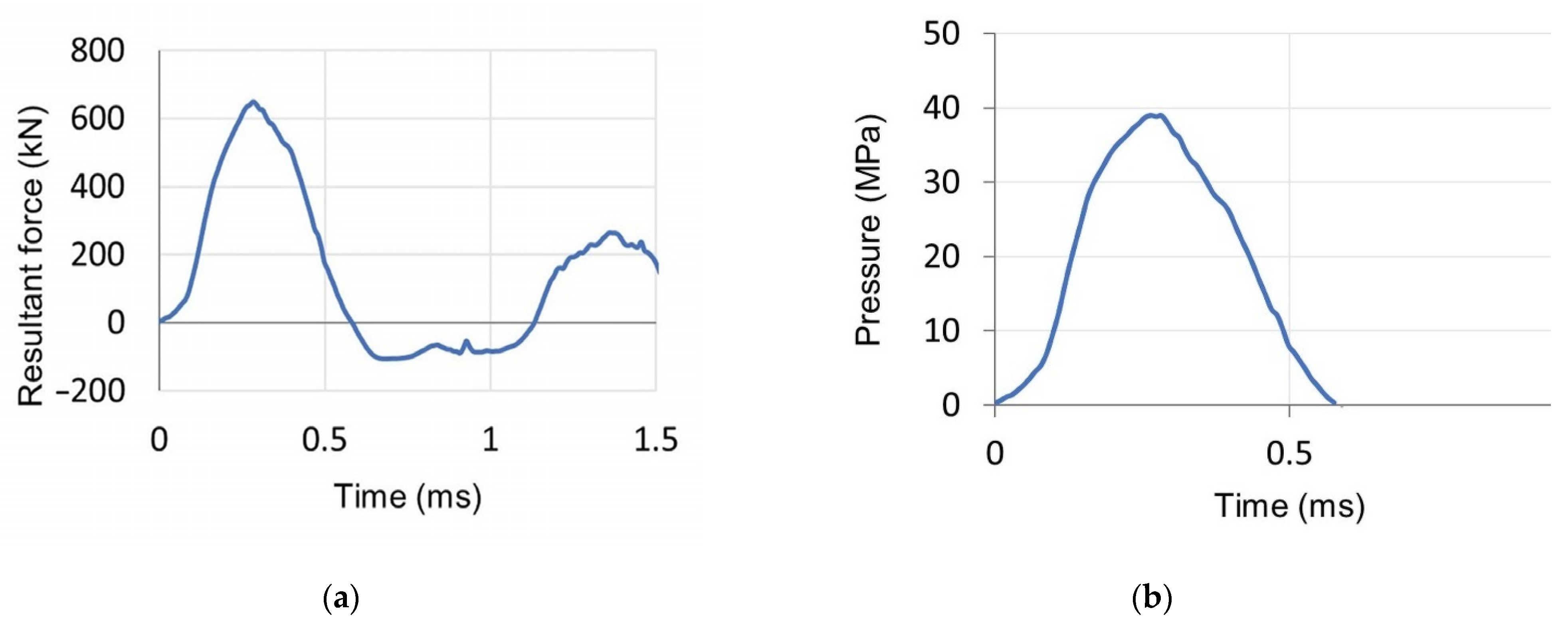
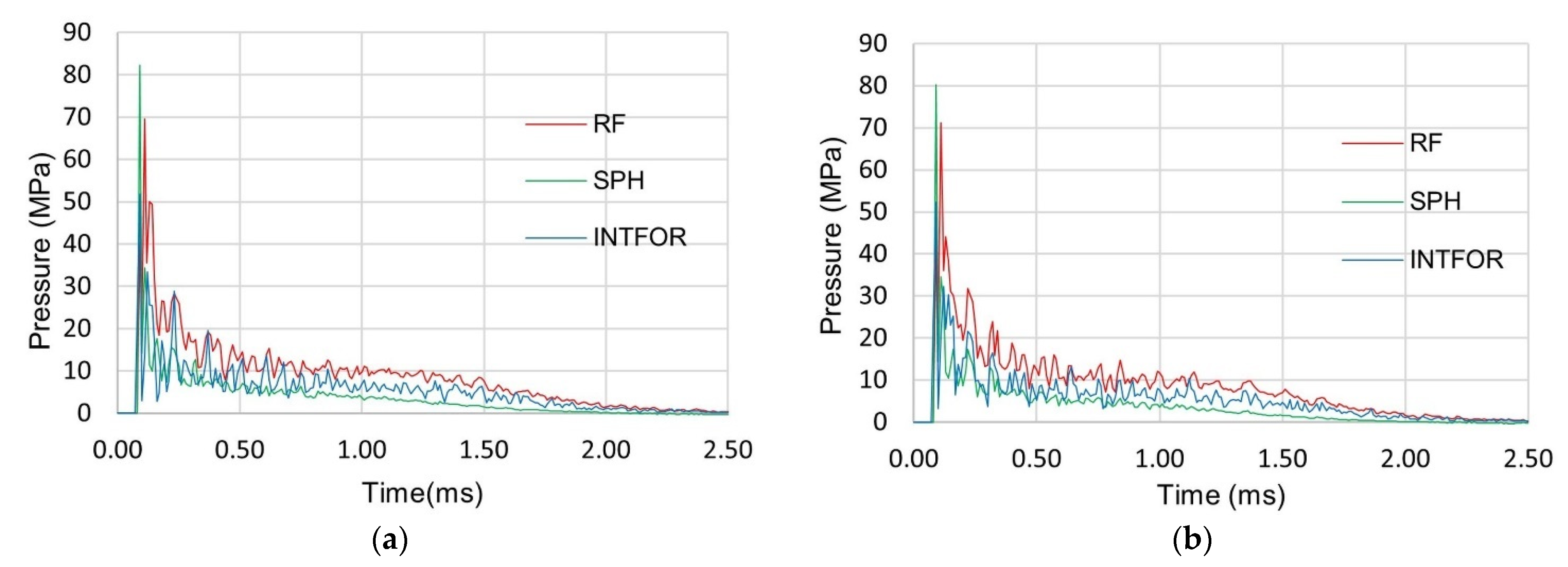
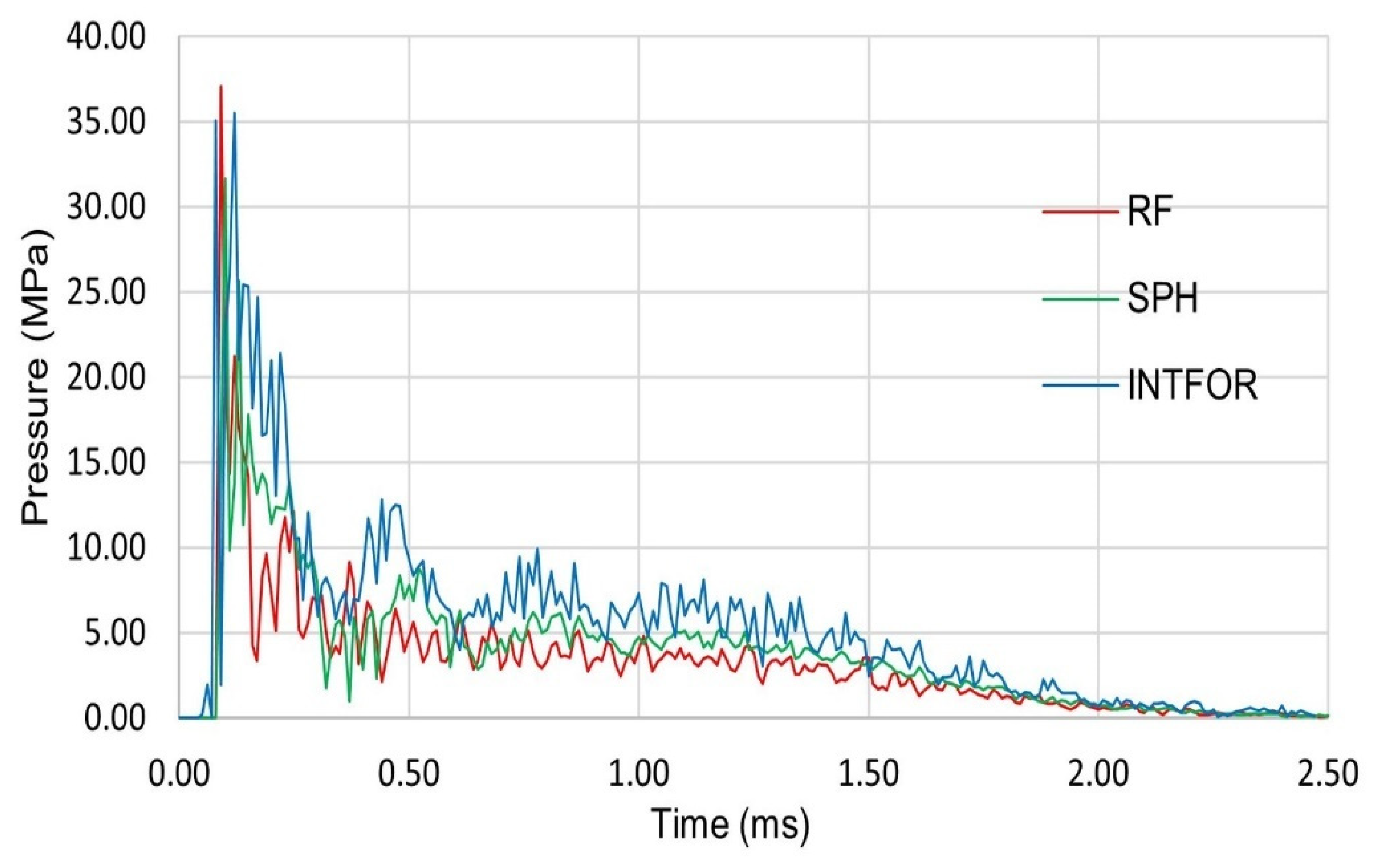



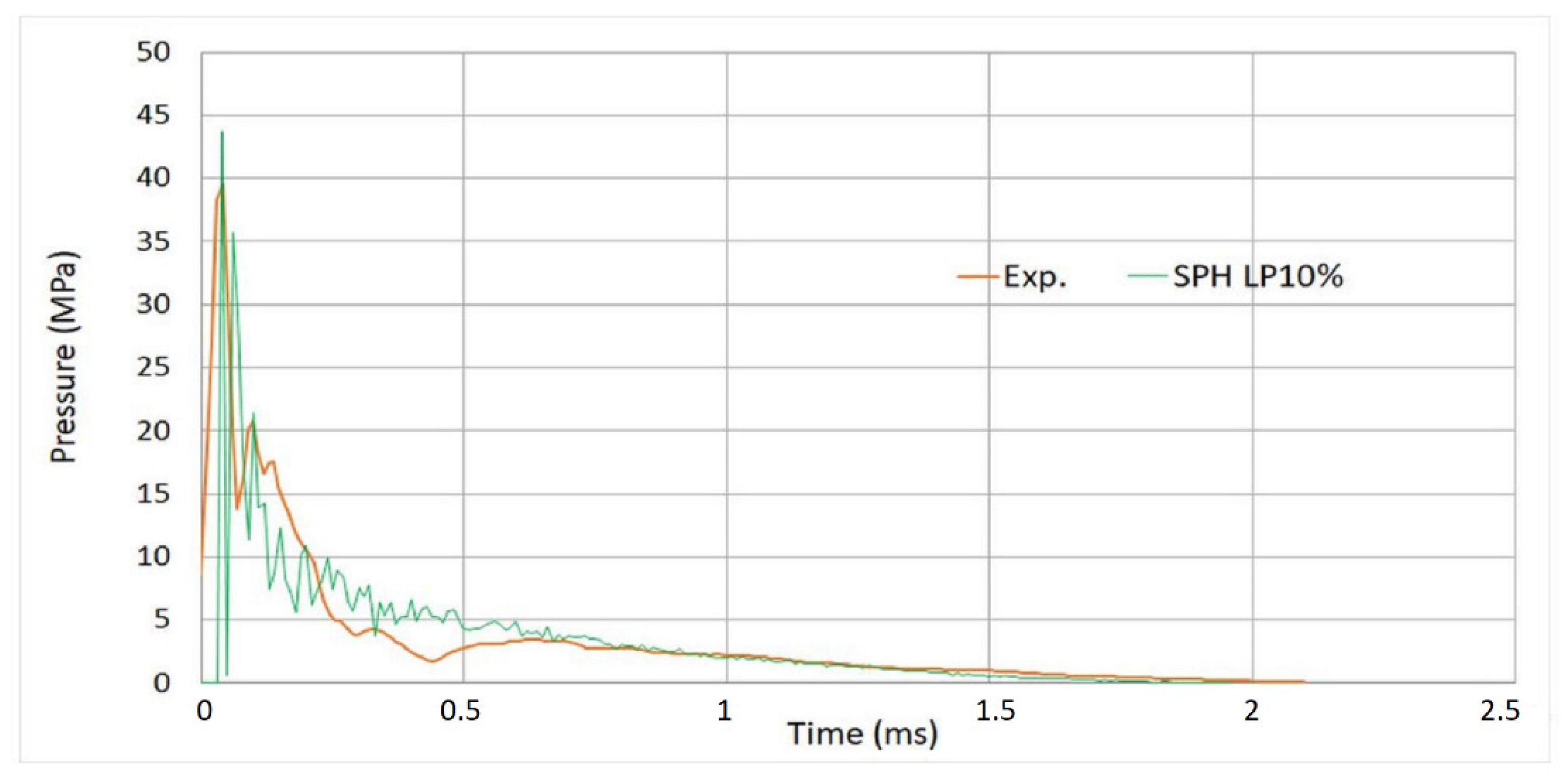
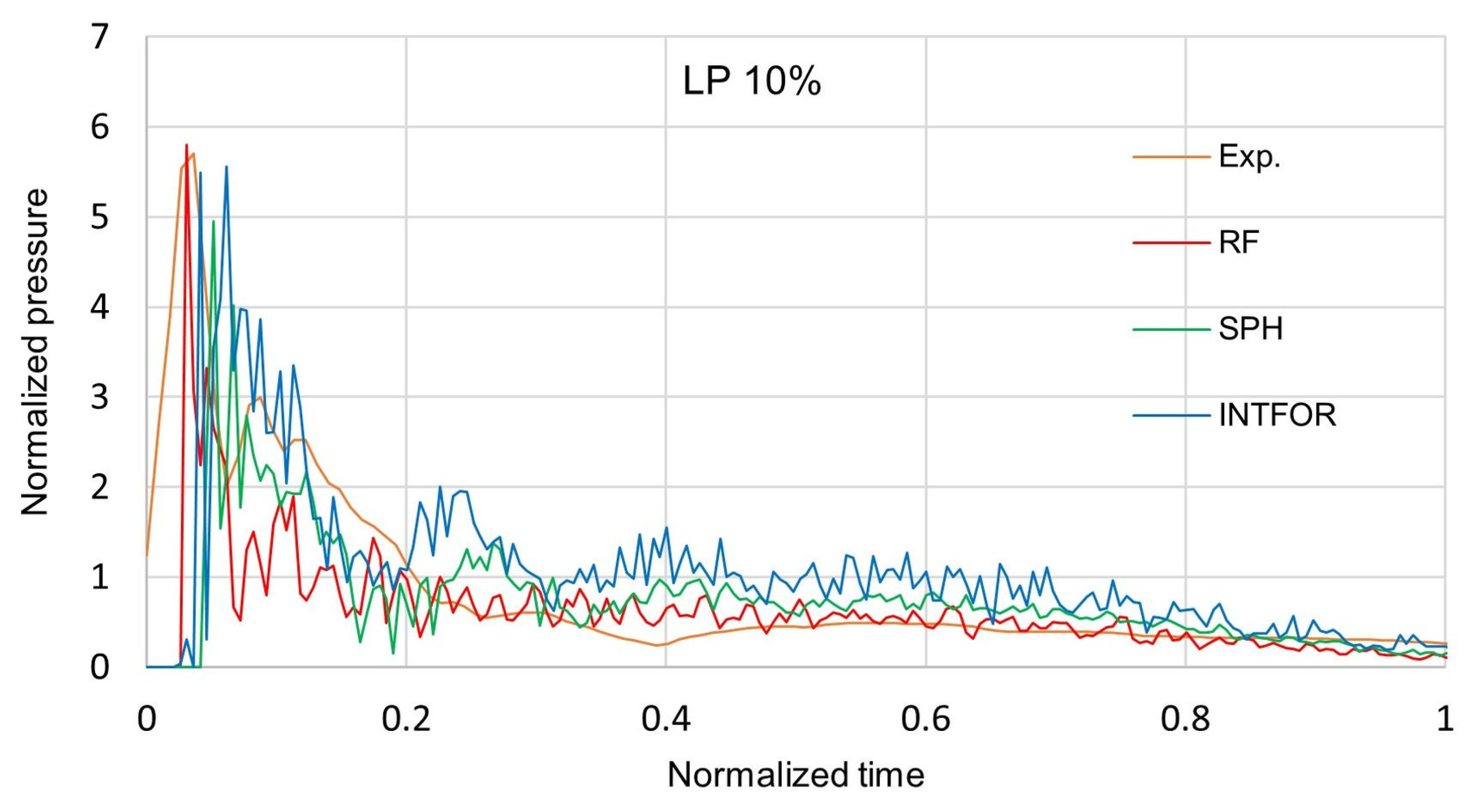

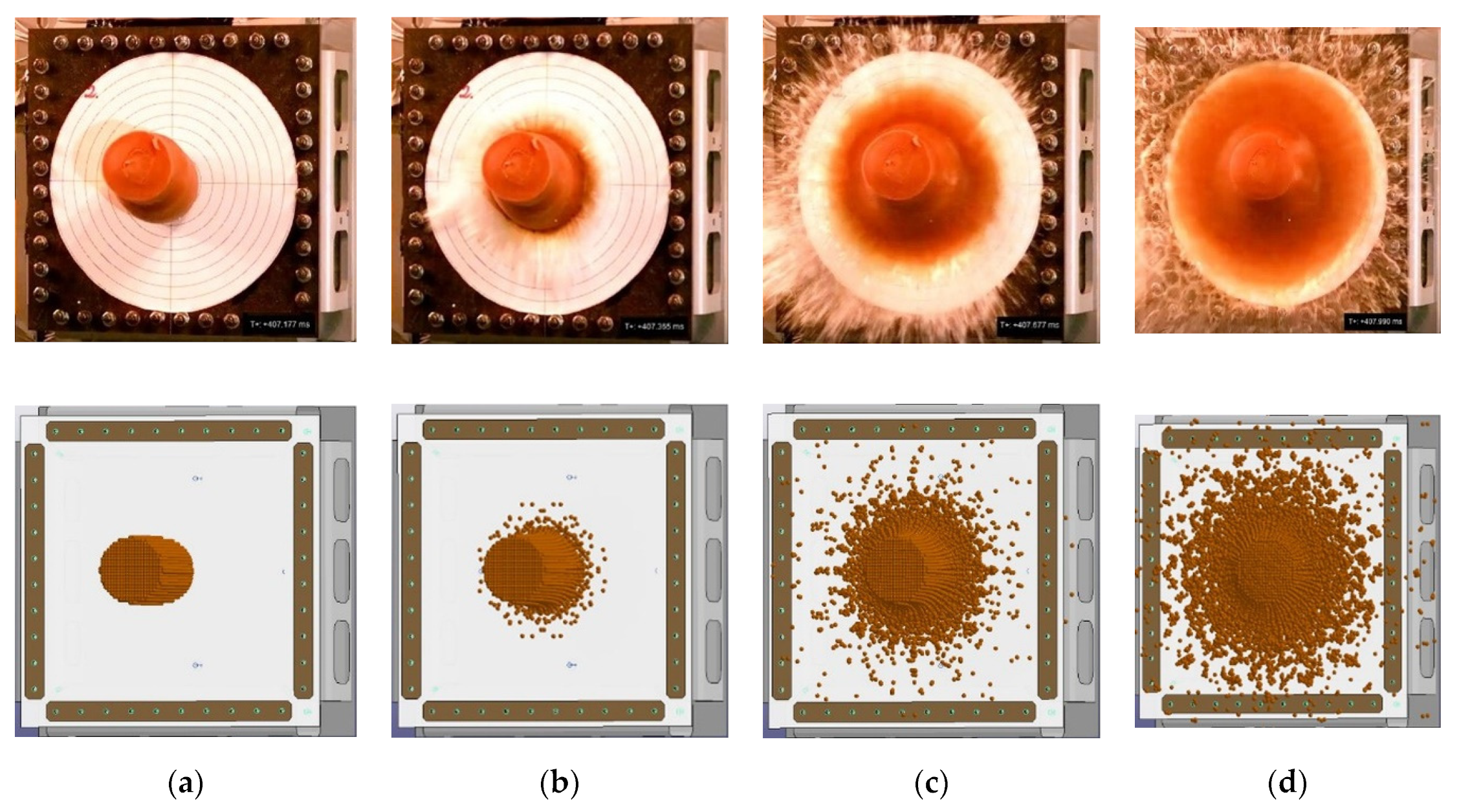
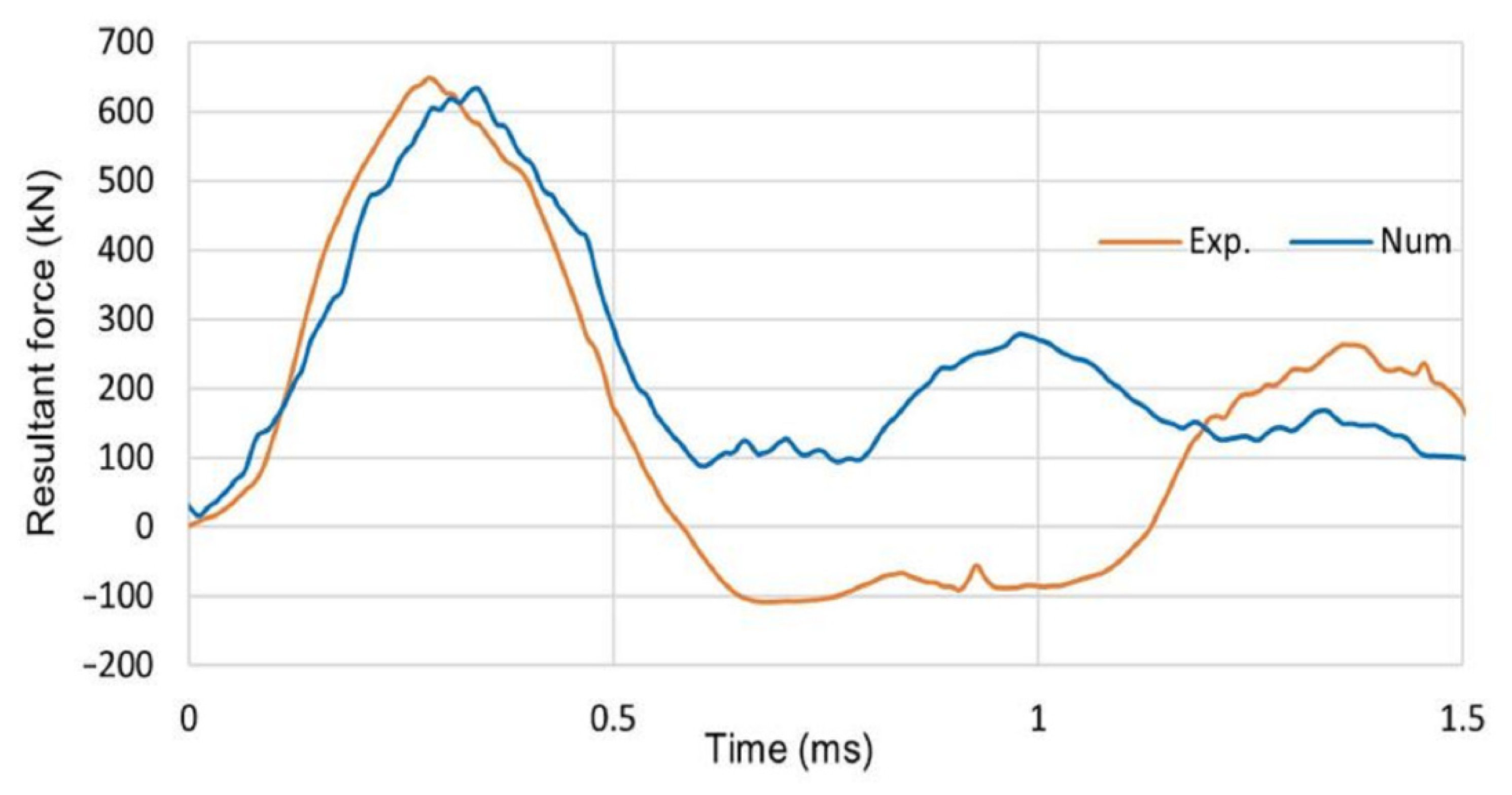
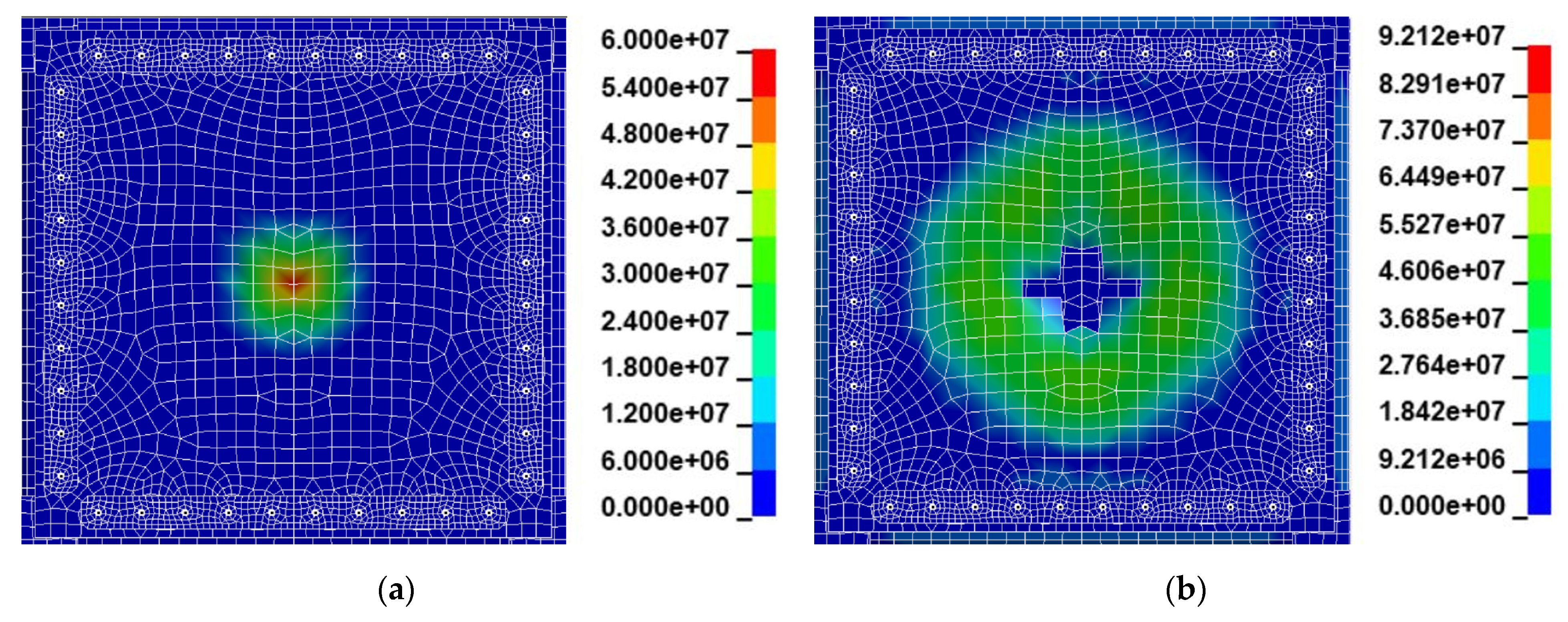

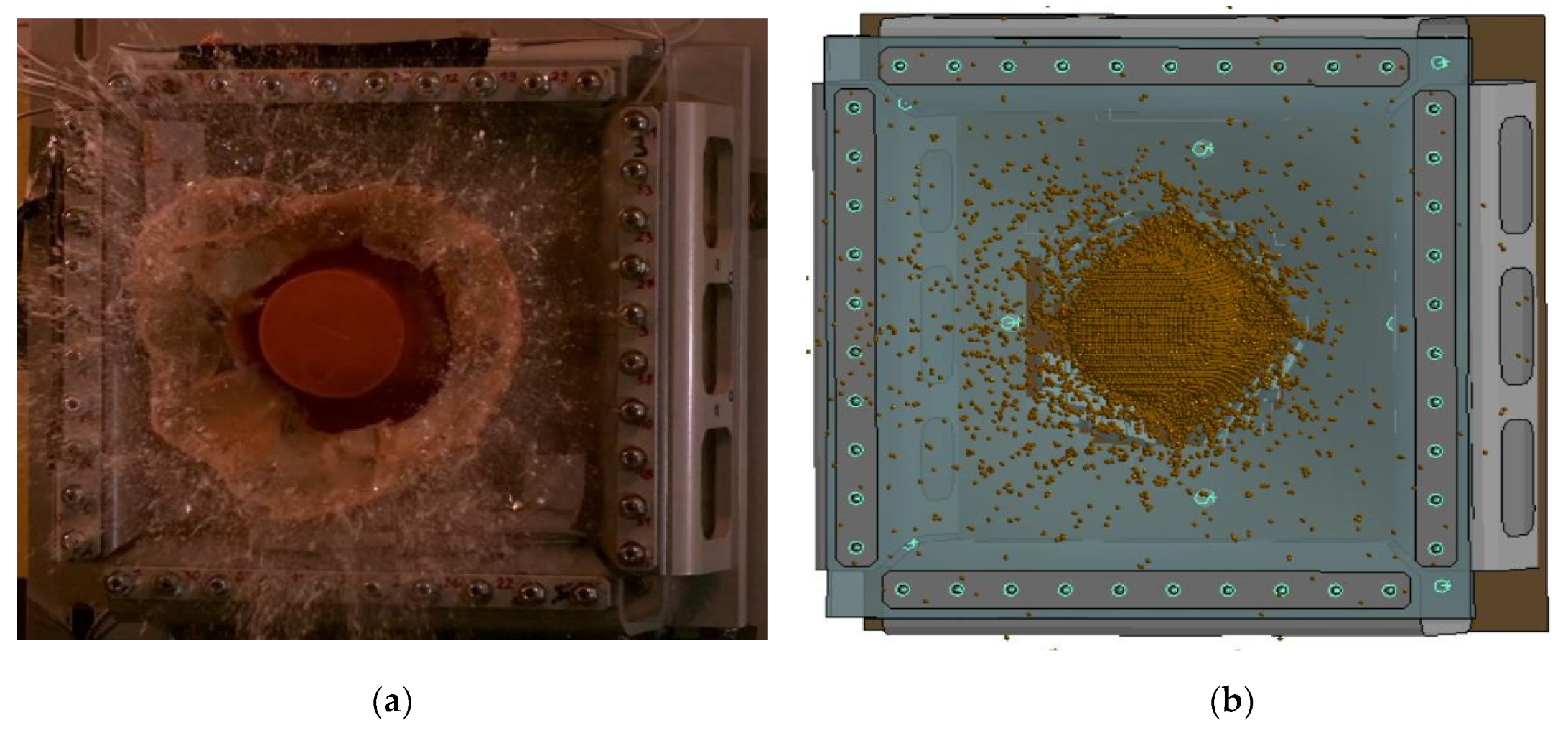
| Material Parameters of Bird Models | ||||
| Density | Cut-Off Pressure | Viscosity Coefficient | Relative Volume for Erosion in Tension | Relative Volume for Erosion Compression |
| [kg/m3] | [Pa] | [Pa·s] | [-] | [-] |
| 950 | –106 | 0.001 | 1.1 | 0.8 |
| Grüneisen’sEOS Parameters | ||||
| Bulk Speed of Sound | Linear Coefficient | Quadratic Coefficient | Cubic Coefficient | Grüneisen’s Gamma |
| [m/s] | [-] | [-] | [-] | [-] |
| 1.438 | 1.92 | 0 | 0 | 0.1 |
| Data of Steel Plate Material (0.5 × 0.5 × 0.1 m) | ||||||
|---|---|---|---|---|---|---|
| Density | Young’s Modulus | Poisson’s Ratio | Yield Stress | Failure Strain | Tangent Modulus | Hardening Parameter |
| [kg/m3] | [Pa] | [-] | [Pa] | [-] | [Pa] | [-] |
| 7.850 | 210 × 109 | 0.3 | - | - | - | - |
| Data of Plexiglass Plate Material (0.5 × 0.5 × 0.1 m) | ||||||
| 1.190 | 3200 × 106 | 0.35 | 6000 × 107 | 0.067 | - | 0.5 |
| Initial Simulation Parameters | Description |
|---|---|
| Element type of bird models | SPH elements |
| Element type of the rigid plate (target) | Belytschko-Tsay shell elements |
| Contact type | Automatic nodes to surface Automatic single surface Force transducer |
| Hourglass control | Flanagan-Belytschko viscous form (IHQ = 2) Coefficient (QM = 0.14) |
| Bulk viscosity control | Quadratic viscosity coefficient (Q1 = 2.0) Linear viscosity coefficient (Q2 = 0.25) |
| Time step | 6 × 10−6 s |
| Initial velocity | 116 m/s |
| The analysis time | 2.5 ms |
| Authors | Normalized Hugoniot Pressure | Normalized Steady Pressure | Technique of Pressure Recording | |
|---|---|---|---|---|
| 1. | Johnson and Holzapfel [19] | 7.2 | 1.4 | Not stated |
| 2. | Jenq et al. [19] | 6.5 | 1.0 | Not stated |
| 3. | Lavoie et al. [20] | 14 | 0.9 | Center of impact |
| 4. | Tao and Smith [19] | 5.5 | 1.1 | Not stated |
| 5. | Smojver and Ivancevic [19] | 12.6 | 1.58 | Not stated |
| 6. | Ivancevic and Smojver [33] | 9.0 | 1.58 | Not stated |
| 7. | Wilbeck [16] | 3.6 | 0.5 | Experiment |
| 8. | Ćwiklak Janusz | 14.1 | 1.0 | INTFOR, coarse mesh |
| 9. | Ćwiklak Janusz | 5.78 | 0.6 | Experiment |
| 10. | Ćwiklak Janusz | 5.81 | 0.7 | RF |
| 11. | Ćwiklak Janusz | 4.98 | 0.9 | SPH |
| 12. | Ćwiklak Janusz | 5.57 | 1.0 | INTFOR |
Publisher’s Note: MDPI stays neutral with regard to jurisdictional claims in published maps and institutional affiliations. |
© 2022 by the authors. Licensee MDPI, Basel, Switzerland. This article is an open access article distributed under the terms and conditions of the Creative Commons Attribution (CC BY) license (https://creativecommons.org/licenses/by/4.0/).
Share and Cite
Ćwiklak, J.; Kobiałka, E.; Goś, A. Experimental and Numerical Investigations of Bird Models for Bird Strike Analysis. Energies 2022, 15, 3699. https://doi.org/10.3390/en15103699
Ćwiklak J, Kobiałka E, Goś A. Experimental and Numerical Investigations of Bird Models for Bird Strike Analysis. Energies. 2022; 15(10):3699. https://doi.org/10.3390/en15103699
Chicago/Turabian StyleĆwiklak, Janusz, Ewelina Kobiałka, and Artur Goś. 2022. "Experimental and Numerical Investigations of Bird Models for Bird Strike Analysis" Energies 15, no. 10: 3699. https://doi.org/10.3390/en15103699
APA StyleĆwiklak, J., Kobiałka, E., & Goś, A. (2022). Experimental and Numerical Investigations of Bird Models for Bird Strike Analysis. Energies, 15(10), 3699. https://doi.org/10.3390/en15103699






